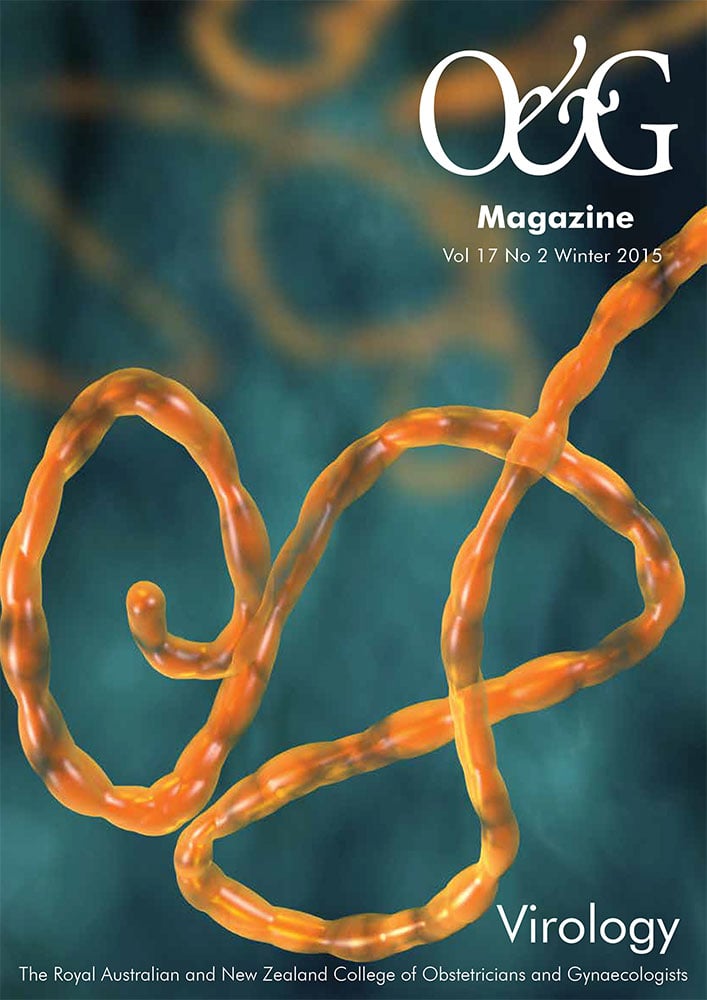Parvovirus – also known as ‘slapped cheek syndrome’ or ‘fifth disease’ – is a common viral infection that often affects children and those in close association, such as early years teachers. Outside of pregnancy it is a mild disease with few sequelae. However, parvovirus infection in pregnancy can result in miscarriage, fetal anaemia, hydrops or stillbirth. It is caused by Parvovirus B19 a small, single-stranded DNA virus that affects only humans. It is described as genotype 1 of the Erythrovirus genus belonging to the Parvoviridae family. The name implies multiple parvovirus types, but stems from the initial discovery of the virus when screening donor blood for Hepatitis B it was found on sample 19 in panel B. The other two genotypes (2 and 3) are found less commonly in the USA and Europe, but are more common in those who are immunosuppressed. Genotype 3 is typically more common in Sub-Saharan Africa and South America although it does appear to be spreading.1 Parvovirus B19 will be considered more closely in this review.
Incidence and transmission
The incidence of Parvovirus B19 antibody presence increases with age. In a study that examined the serum of more than 2000 participants, more than 85 per cent of people over the age of 70 tested positive for the IgG.2 Most infection seems to occur during the school years as 50–60 per cent of these children were already IgG positive.
Outbreaks have been reported as occurring in four-year cycles, with two years of epidemic followed by two years of endemic.3 The nonspecific signs and symptoms of this infection may influence under-diagnosing and reporting, however.
Transmission occurs via three routes. The most common is respiratory, with the virus present in both respiratory secretions and saliva. This route is likely to be responsible for transmission rates of 50 per cent in household contacts. Haematogenous transmission is also possible. In New Zealand there is a warning attached to Prothrombinex™-VF as there have been rare cases of transmission via similar products. For the obstetrician, the route of transmission of most interest is vertical. The rate of vertical transmission in a woman with acute parvovirus infection is 50 per cent. This can result in inhibition of erythropoiesis and stimulation of apoptosis, leading to fetal anaemia, hydrops and fetal demise. Fetal thrombocytopenia is also reported.4
Time course of infection
Viraemia is typically present six days after exposure and lasts for around a week. As people are contagious before they are symptomatic, containing the spread of disease is not easily done. The development of rash marks the end of the infectious period, usually one-to-two weeks after infection.
Clinical manifestations
Infection is asymptomatic in 25 per cent of people. It produces nonspecific symptoms of fever, muscle pain and malaise in another 50 per cent. The remaining 25 per cent show more specific disease manifestations: including erythema infectiosum, a febrile illness associated with rash, arthropathy, transient aplastic crisis and red blood cell aplasia. The initial phase of infection in erythema infectiosum consists of around a week of non-specific symptoms, which can include fever, malaise, diarrhoea, headache and nausea. The classic slapped cheek rash then occurs and may be followed by a lace- like rash over the trunk and limbs, typically seen one-to-four days later. This is common in children.
Arthropathy occurs mainly in adult women and is associated with rash in 75 per cent of cases, although the appearance is not always as characteristic as it is in children. The symptoms can last for around three weeks; however, there are no destructive bony effects.
Transient aplastic crisis is common in those with pre-existing haematological abnormalities, such as sickle cell disease or iron deficiency anaemia. These patients present with symptoms of anaemia, with haemoglobin levels around 30 per cent lower than normal. Transfusion can be used if necessary, but the effects of infection are self-limiting, usually lasting up to three weeks.
Parvovirus B19 in pregnancy
Incidence of acute infection in pregnancy has been reported as two to four per cent.5 6 7 There is no role for routine screening in a low-risk population. Although childcare workers are at an increased risk of exposure, the Australasian Society for Infectious Diseases does not recommend these women stop working as the overall risk of infection is similar to those exposed in the general community.8
The risk of vertical transmission is 50 per cent.9 Infection between eight and 20 weeks poses the greatest risk to the fetus. When vertical transmission occurs, fetal disease manifestation usually presents from two weeks post-infection with 93 per cent being present by eight weeks. Up to a quarter of fetuses will develop anaemia, some of which will spontaneously resolve, however up to 12 per cent develop fetal hydrops.10 This is thought to be owing to both high output cardiac failure secondary to anaemia, but also direct myocardial injury following infection of myocardial cells. Death occurs in five to ten per cent of infected fetuses.11 This means that up to five per cent of fetuses will die when maternal infection is present. Although some case reports suggest association between infection and congenital abnormality, there is no real evidence Parvovirus B19 is a teratogen.12 There is also no evidence that the virus is directly responsible for poor long-term neurological function.
Diagnosis
Diagnosis of past infection is represented by positive IgG with negative IgM. A positive IgM result can be seen between ten days and three months post exposure and suggests acute infection. The sensitivity of the radioimmunoassay and enzyme-linked immunoassay tests is 80–90 per cent. Polymerase chain reaction testing is better at picking up very small amounts of B19 DNA and can be reserved for women with a clear history of exposure and a negative IgM and for diagnosing fetal infection from amniotic fluid samples. Sampling of amniotic fluid is not necessary, but if an amniocentesis was being performed for other reasons, such as karyotyping, the test could be done for confirmation.
Management
There is no specific treatment for Parvovirus B19; however, some of the effects of the virus can be treated. Following confirmation of acute infection by seroconversion in the mother, there should be monitoring with ultrasound for evidence of fetal anaemia and hydrops. This monitoring should start four weeks post conversion/infection and continue for up to 12 weeks, as this is the window of greatest risk to the fetus. Ultrasound may indicate signs of severe anaemia and hydrops, including skin oedema, ascites and pleural and pulmonary oedema.
Diagnosis of fetal anaemia should be suspected when assessment of the middle cerebral artery Doppler peak systolic velocity (MCA PSV) is greater than 1.5MoM (multiples of the mean). Where severe anaemia is suspected (MCA PSV >1.5 MoM), a fetal blood sample should be performed to quantify this and also to check for platelets as thrombocytopenia can occur concurrently.13 Cordocentesis in these cases can lead to fetal exsanguination.
Identification of fetal hydrops or suspected anaemia should trigger urgent referral to a fetal medicine specialist unit able to undertake in utero transfusion. If the fetus is near term, delivery can be considered. Intrauterine transfusion is not without risk; however, studies suggest that mortality is higher in those who do not undergo transfusion than those who do. One study of 539 cases of Parvovirus B19-induced hydrops reported mortality rates of six per cent in the fetuses who underwent transfusion and 30 per cent in those that did not. A third of the fetuses with hydrops had spontaneous resolution.14
Where fetal hydrops is present, delivery should be at a hospital with a level-3 neonatal intensive care unit. A specialist paediatrician should attend the delivery as intubation and fluid drainage may be necessary. The baby might require ventilation and possibly other support, such as inotropes. A haemoglobin and platelet count should be taken on day 1 and appropriate transfusion given where necessary.
There is no risk of recurrence to the affected mother or child.
Summary
Parvovirus B19 is a DNA virus with moderate rates of transmission from individuals who may be asymptomatic. Around 30–40 per cent of pregnant women are not immune and are therefore at risk. Although rare, the consequences of fetal hydrops and death are devastating and any suspected exposure must be investigated so that appropriate fetal monitoring and treatment may be arranged.
References
- Parsyan A, Szmaragd C, Allain JP, Candotti D. Identification and genetic diversity of two human parvovirus B19 genotype 3 subtypes. J Gen Virol 2007; 88:428.
- Cohen BJ, Buckley MM. The prevalence of antibody to human parvovirus B19 in England and Wales. J Med Microbiol 1988; 25:151.
- Kelly HA, Siebert D, Hammond R, Leydon J, Kiely P, Maskill W. The age-specific prevalence of human parvovirus immunity in Victoria, Australia compared with other parts of the world. Epidemiology and Infection. 2000;124(3):449-457.
- Melamed N, Whittle W, Kelly EN, Windrim R, Seaward PG, Keunen J, Keating S, Ryan G. Fetal thrombocytopenia in pregnancies with fetal human parvovirus-B19 infection Am J Obstet Gynecol 2015;212.
- van Gessel PH, Gaytant MA, Vossen AC, Galama JM, Ursem NT, Steegers EA, et al. Incidence of parvovirus B19 infection among an unselected population of pregnant women in the Netherlands: A prospective study. Eur J Obstet Gynecol Reprod Biol. 2006;128(1-2):46-49.
- Gratacos E, Torres PJ, Vidal J, Antolin E, Costa J, Jimenez de Anta M et al. The incidence of human parvovirus B19 infection during pregnancy and its impact on perinatal outcome. J Infect Dis 1995;171: 1360-63
- Sarfraz A, Samuelsen S, Bruu A-L, Jenum P, Eskild A. Maternal human parvovirus B19 infection and the risk of fetal death and lowbirthweight: a case–control study within 35 940 pregnant women. BJOG 2009;116:1492-1498.
- van Gessel PH, Gaytant MA, Vossen AC, Galama JM, Ursem NT, Steegers EA, et al. Incidence of parvovirus B19 infection among an unselected population of pregnant women in the Netherlands: Aprospective study. Eur J Obstet Gynecol Reprod Biol. 2006;128(1-2):46-49.
- Palasanthiran P, Starr M, Jones C, Giles M, editors. Management of perinatal infections. Sydney: Australasian Society for Infectious Diseases (ASID); 2014. Available from: www.asid.net.au/ documents/item/368 .
- Lamont R, Sobel J, Vaisbuch E, Kusanovic J, Mazaki-Tovi S, Kim S et al. Parvovirus B19 infection in human pregnancy. BJOG 2011;118:175-186.
- Lamont R, Sobel J, Vaisbuch E, Kusanovic J, Mazaki-Tovi S, Kim S et al. Parvovirus B19 infection in human pregnancy. BJOG 2011;118:175-186.
- Palasanthiran P, Starr M, Jones C, Giles M, editors. Management of perinatal infections. Sydney: Australasian Society for Infectious Diseases (ASID); 2014. Available from: www.asid.net.au/ documents/item/368 .
- Melamed N, Whittle W, Kelly EN, Windrim R, Seaward PG, Keunen J, Keating S, Ryan G. Fetal thrombocytopenia in pregnancies with fetal human parvovirus-B19 infection Am J Obstet Gynecol 2015;212.
- Lamont R, Sobel J, Vaisbuch E, Kusanovic J, Mazaki-Tovi S, Kim S et al. Parvovirus B19 infection in human pregnancy. BJOG 2011;118:175-186.






Leave a Reply